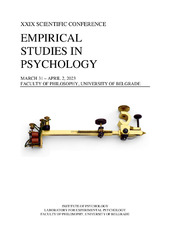Приказ основних података о документу
Meaning, role and sources of hope among refugee adolescents and youth
| dc.creator | Dimoski, Jana | |
| dc.creator | Milić, Ana | |
| dc.creator | Vukčević Marković, Maša | |
| dc.date.accessioned | 2023-11-24T12:37:07Z | |
| dc.date.available | 2023-11-24T12:37:07Z | |
| dc.date.issued | 2023 | |
| dc.identifier.isbn | 978-86-6427-247-6 | |
| dc.identifier.uri | http://reff.f.bg.ac.rs/handle/123456789/5401 | |
| dc.description.abstract | The majority of previous research on refugee adolescents and youth focused on psychopathology, and evidence on positive capacities such as hope remains scarce even though there are findings indicating they are important contributors to refugees’ mental health. The aim of this research was to explore the meaning, role, and sources of hope among refugee adolescents and youth. A qualitative methodology was applied and 11 full semi-structured interviews were conducted with refugees from 15 to 24 years of age (Mage = 19.18, SDage = 2.82, 73% males), from 8 Middle Eastern and African countries. Thematic analysis and emphatic interpretation were used and four main themes emerged – Nature of hope, Hope-goal interaction, Function of hope, and Keeping hope. The results imply that, mostly, participants perceive hope as something that is learned throughout life, and not as something that is hereditary. Moreover, hope is perceived as non-linear – it can be enhanced but also decreased or lost, and sometimes it is closely tied to life events refugees are facing. A highly salient perception is that hope is closely tied to particular goals and is not general and independent. Some of the participants viewed hope as the last resort when there is nothing else that can be done and some of them view hope as the most important when referring to goals that are highly controllable. The function of hope is perceived as two-fold – on one hand, it can serve as consolation, peace, and calmness, and on the other hand, it can motivate, empower and encourage. Finally, it is noted that common sources of hope (e.g., family, friends) are not available to participants, while other refugees on the road do not have the emotional and physical capacities to lift hope. Hence, the only available sources of hope mentioned by the participants is self-reliance (e.g., proactive approach, emotional regulation) and professional support (psychologists, teachers, legal guardians). Support in lifting hope can be various: instrumental, informational, and emotional, while some qualities of support are also stressed as important in lifting hope – how we talk, our presence and continuity of support, and strictly avoiding providing fake hope to refugee adolescents and youth. Although the limitation of this study is a small sample size, it improves the overall understanding of hope in refugee adolescents and youth, its meaning, role, and sources, and is mostly discussed in terms of practical relevance in direct work. | sr |
| dc.language.iso | en | sr |
| dc.rights | openAccess | sr |
| dc.rights.uri | https://creativecommons.org/licenses/by/4.0/ | |
| dc.source | Book of Abstracts, XXIX Scientific Conference Empirical Studies in Psychology, March 31-April 2, Faculty of Philosophy, University of Belgrade | sr |
| dc.subject | refugees | sr |
| dc.subject | adolescents and youth | sr |
| dc.subject | meaning of hope | sr |
| dc.subject | role of hope | sr |
| dc.subject | sources of hope | sr |
| dc.title | Meaning, role and sources of hope among refugee adolescents and youth | sr |
| dc.type | conferenceObject | sr |
| dc.rights.license | BY | sr |
| dc.citation.spage | 130 | |
| dc.identifier.fulltext | http://reff.f.bg.ac.rs/bitstream/id/13560/EIP2023_book_of_abstracts.pdf | |
| dc.identifier.rcub | https://hdl.handle.net/21.15107/rcub_reff_5401 | |
| dc.type.version | publishedVersion | sr |

